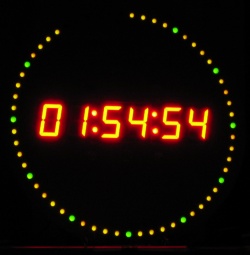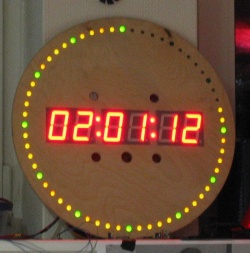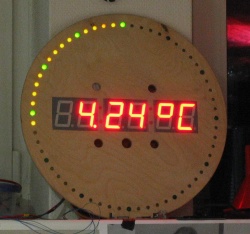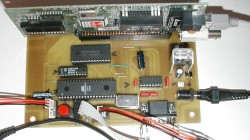| # |
Reichelt Stock Nr. |
Description |
Part-Nr. in the drawings |
| 2 | SAA 1064 | LED-Driver, DIL-24 | IC1, IC2 |
| 2 | GS 24 | IC Socket, 24 pins | N/A |
| 2 | KERKO 2,7N | Capacitor, 2.7nF | C1, C2 |
| 12 | PS 25/5G WS | connector, 5 pins | K2 - K13 |
| 1 | PS 25/3G WS | connector, 3 pins | K1 |
| 1 | PS 25/2G WS | connector, 2 pins | K18 |
| 4 | SL 1X36G 2,54 (?) |
connector, 2 pins - these are just the normal pins you would use for jumpers. |
K14 - K17 |
| 1 | FHPCU 160x100 | Photo coated copper board | N/A |
| 4 | BC 140-10 | Transistor BC140 | T1 - T4 |
| 3 | AX 100/25 | Electrolyte capacitor, 100µF | C3 - C5 |
| 2 | 1N 4001 | Diode 1 N 4001 | D9, D10 |
| 1 | ? | Power supply connector | Bu1 |
| 1 | LED 5MM ST RT | standard LED red (to show wrong supply polarity) | LED10 |
| 1 | LED 5MM ST GN | standard LED green | LED11 |
| 1 | METALL 560 | resistor, about 500 Ohm (for the 2 LEDs above) | R1 |
| 8 | LED 5MM R OR | 2.5 x 5 mm rectangular LED orange | LED1 - LED8 |
| 3 | SPL 20 |
IC Socket with only one row (used for the 7 segment digits, they are not
directly soldered onto the board, but instead get mounted on these) |
N/A |
| 6 | SA 23-12 RT |
7 segment LED digits, 57 mm digit height, Kingbright SA23-12SRWA (Super Bright Red, Common Anode) |
N/A |
| 4 | LED 8-4500 RT |
big LEDs (for the dots), grinded so they got a flat top |
N/A |
| # |
Reichelt Stock Nr. |
Description |
Part-Nr. in the drawings |
| 1 | BEL 160x100-1 | Photo coated copper board | N/A |
| 1 | GS 40 | IC Socket, 40 pins | N/A |
| 1 | ATMEGA 8515-16 | Microcontroller, DIP40 | IC1 |
| 1 | 74HCT 573 | 8 bit flipflop | IC2 |
| 1 | 62256-80 | SRAM, 32Kx8 | IC3 |
| 1 | OSZI 8,000000 | Oscillator, 8 Mhz | Q1 |
| 1 |
MAX 232 ECPE |
Serial Interface Converter (+5V TTL -> ±12V RS232) |
IC4 |
| 1 |
LM 1084 IT5,0 |
Voltage Regulator 5V, 5A.
NOTE: Heatsink required! |
IC6 |
| 1 | STECKER 62-254 | 8 bit ISA slot (2 x 31 pins) | ISA1 |
| 1 | TASTER 1082.3 | nice red Reset-Button | K11 |
| 2 | 1N 4001 | Diode, 1A | D1, D2 |
| 4 | MKS-2 100N | Ceramic Capacitor, 100nF | C3, C4, C6, C7 |
| 2 | RAD 100/25 | Electrolyte Capacitor, 100uF (standing) | C5, C8 |
| 2 | AX 100/25 | Electrolyte Capacitor, 100uF (lying) | C1, C2 |
| 1 | METALL 10,0K | Resistor, 10K | R1 |
| 1 | D-SUB ST 09EU | Serial Port | K2 |
| 1 | ? | Power supply connector | Bu1 |
| ...and various connectors not listed here (use what fits
you best, or use the ones from the LED module part list). |







